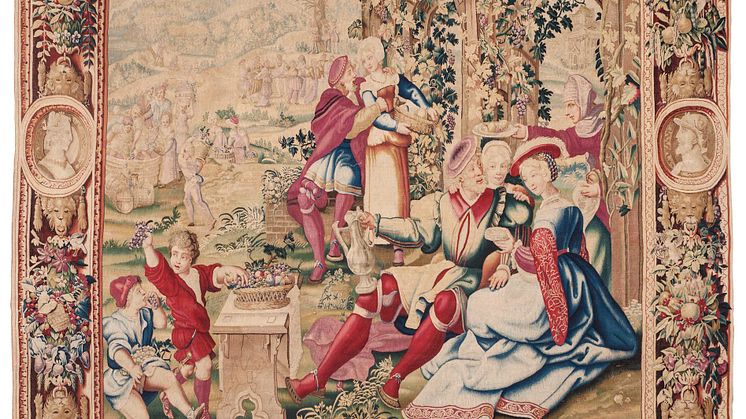
Press release -
New acquisition: A French tapestry with Swedish provenance
Nationalmuseum
has acquired a French tapestry from the 18th century depicting an allegory of
the month of October. It was originally one of a twelve-piece series presented
to Eric Sparre on his departure as ambassador in France in 1717. The
acquisition means that two of the original twelve tapestries are now back in
Sweden.
Nationalmuseum’s collection of woven tapestries has expanded with the addition of a tapestry depicting an allegory of the month of October. The work was originally one of a twelve-piece series covering the months of the year, Les Mois de Lucas, commissioned by King Louis XIV in 1712 from the Royal Gobelins Manufactory in Paris. The suite of tapestries was presented by his great-grandson Louis XV to the Swedish diplomat and field marshal Count Eric Sparre (1665–1726) on his departure as ambassador in 1717.
Seven of the original twelve works are known to still exist. Before Nationalmuseum made its acquisition, there was only one remaining in Sweden. The recently purchased tapestry left Sweden when parts of Carl Robert Lamm’s collection were sold in New York in 1923. Lamm had acquired the tapestry in around 1900 from a Swedish individual, who claimed that it had been part of the Swedish Royal Collection. It has, however, not been possible to verify this.
The motif of the tapestry refers back to a suite woven in Brussels in around 1535 that was wrongly attributed to the artist Lucas van Leyden, hence the name Les Mois de Lucas. Despite its old-fashioned nature, it was copied several times during the period 1680–1770. The centre panel depicts a party being offered wine and autumnal fruit. The landscape in the background shows a harvest scene. The border is decorated with bold garlands of flowers and fruit, as well as medallions carrying portraits in profile.
The well-preserved tapestry, whose colours retain much of their original vibrancy, was purchased with the aid of the Axel and Nora Lundgren Fund. It is an important addition to Nationalmuseum’s collection of antique woven tapestries. Nationalmuseum has no budget of its own for new acquisitions, but relies on gifting and financial support from private funds and foundations to enhance its collections of fine art and craft.
Further information for media
Hanna Tottmar,
press officer, hanna.tottmar@nationalmuseum.se, +46 767 23 46 32
Caption
Les Gobelins, Tapestry October, 1712. Photo: Linn
Ahlgren/Nationalmuseum.
Categories
Nationalmuseum is Sweden’s premier museum of art and design. The collections comprise older paintings, sculpture, drawings and graphic art, and applied art and design up to the present day. The museum building is currently under renovation and scheduled to open again in 2017. In the meantime, the museum will continue its activities through collaborations, touring exhibitions and a temporary venue at the Royal Swedish Academy of Fine Arts, Fredsgatan 12, Stockholm. Nationalmuseum collaborates with Svenska Dagbladet, FCB Fältman & Malmén and Grand Hôtel Stockholm. For more information visit www.nationalmuseum.se.

